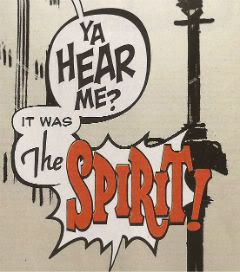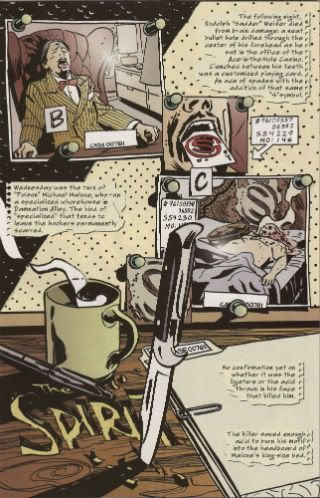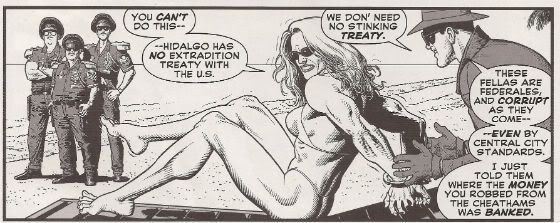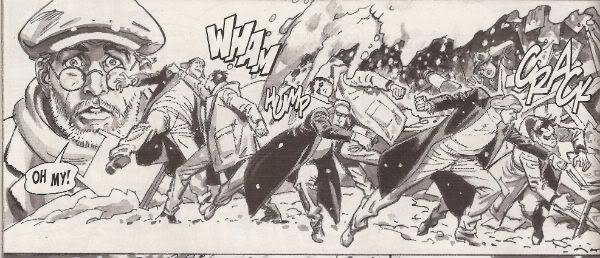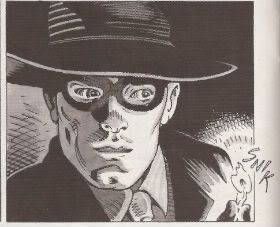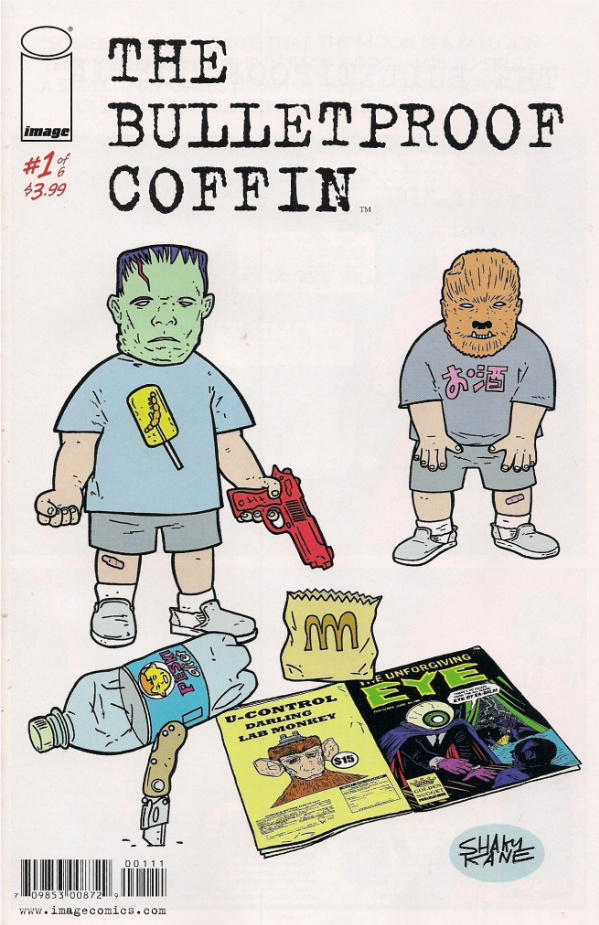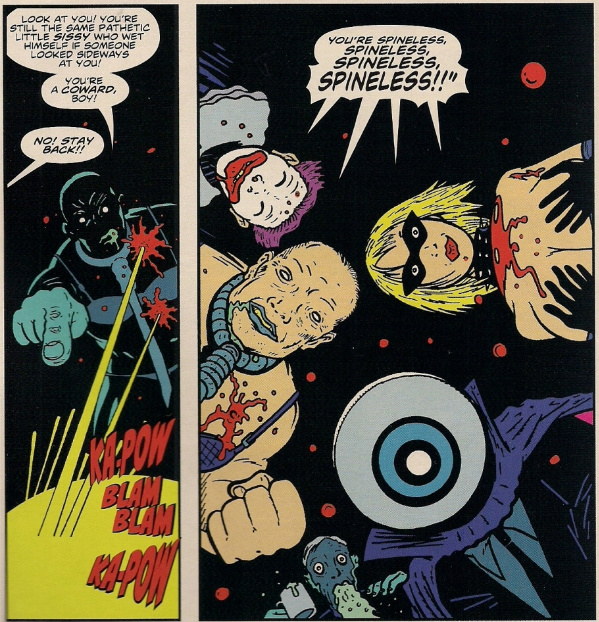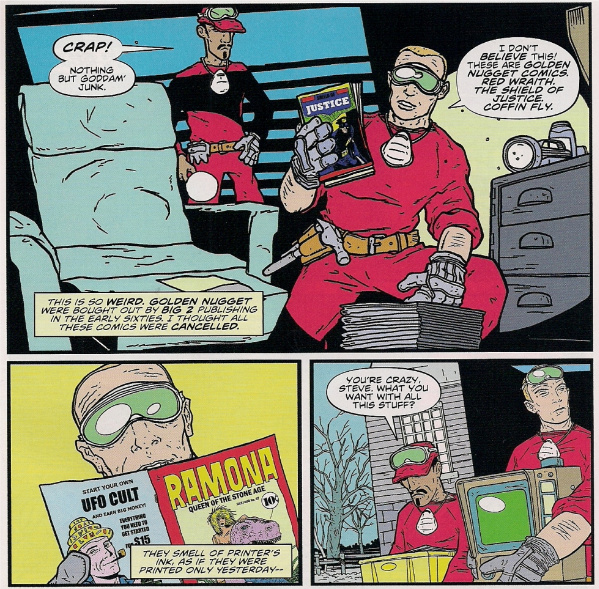"When do I EVER have an alibi?..." Comics! Sometimes they are really good!
/Oh, God! He’s back again! Hopefully he won’t be chittering on about WILL EISNER’S THE SPIRIT (DC Comics, 2010 – 2011)! Um, don’t really know how to break this to you…
WILL EISNER’s THE SPIRT (2010 – 2011)
It’s cancelled now, of course. Living in LCS discount boxes across the globe waiting for eager hands and enquiring minds to alight upon the lovely Ladronn covers and pluck them out for a good hard reading. Doing so would certainly be something I’d recommend. For 17 straight issues Mark Shultz, David Hine and Matthew Sturges delivered the scripting goods. Solid, enjoyable writing all the way only occasionally undercut by decompression, but even when the pages seemed a little unnecessary they were made necessary by the delightful stylings of Moritat, for the most part, but also subs such as Victor Ibanez. Moritat was a revelation in this series; to me a new discovery whose art was a sheer pleasure on every page it graced. If I weren't already signed up for ALL-STAR WESTERN his presence would have ensured it. But it’s cancelled now of course, yet there’s still time for one last look before the final issues slip off the shelf to make way for another tie-in, yet another re-boot, yet another thing that matters less but will sell more. If there’s a lesson to be learned from the demise of WILL EISNER’S THE SPIRIT it’s probably that in today’s wacky world of funnybooks VERY GOOD! will only get you so far but hype will get you further. This series was always the former but had little of the latter and so now it’s cancelled of course. Time for that one last look back then…
WILL EISNER’S THE SPIRIT#16 By John Paul Leon (a), David Hine (w), Daniel Vozzo (c) and Rob Leigh (l) Cover by Ladronn (DC Comics, $2.99)
Consisting as this does of a story told via splash pages this corker is pretty much definitive proof that splash pages can be more than lazy page filling; that the derision and heart-sink I feel when presented with one more big image is more a learned response to their implementation over the past years by wastrels and hacks. It’s an exercise in artistic constraint, the kind Alan Moore (ssshhh! Now, Internet. Shhhh!) regularly delights in tasking himself with. Here the brief is clearly to tell the tale in splashes but each splash has to carry the story forward, include all the relevant visual information, convey mood and, just for yucks, also to include THE SPIRIT logo worked into it unobtrusively. Tell the story basically. In lesser hands it would be a stunt, in even lesser hands a pitiful waste but in hands as nimble and facile as these it becomes a joy. A delightful reminder that those rich in imagination and craft can achieve more when restricted than those who are not so blessed can achieve when given complete freedom.
There are 19 more pages as good as this! I shit thee not!
Clearly the star of the show here is John Paul Leon who carries the major weight of the enterprise. John Paul Leon is known to me from the WINTER MEN series he illustrated Brett Lewis’ words for. The fact that I consider WINTER MEN to be the nearest thing to AMERICAN FLAGG! since AMERICAN FLAGG! probably gives you some idea of the regard with which I already hold his work. A regard that this issue does nothing to diminish. It’s one of those artistic performances you really have to see for yourself. I’m not really one to tell people to buy things sight unseen due to all that nasty subjectivity floating about, but, hey, here I am saying buy this one sight unseen. Your eyes will owe you a pint for it because John Paul Leon’s work here elevates a solid script to EXCELLENT!
WILL EISNER’S THE SPIRIT#17 By Brian Bolland, Jose Luis Garcia Lopez and Brian Bolland (a), Howard Victor Chaykin, Paul Levitz and Will Pfeiffer (w), Rob Leigh and Galen Showman (l) Cover by Ladronn (DC Comics, $2.99)
This final issue of the series contains three short and sharp B/W strips. Such strips formed the back-up of the regular comic until DC cut pages and kept prices down (as opposed to Marvel who cut pages and kept prices up). I guess these were in the can when the axe came down but they make a fine fare thee well for the series.
First up is a strip drawn by Brian Bolland. If I have to tell you about Brian Bolland I can only surmise you have arrived here due your abiding love of bad prose styling rather than your love of comics. For to know comics is to know Brian Bolland and to love one is to love the other. It’s Brian Bolland! and although there’s a stiffness evident that was absent from his hey day he’s still Brian freaking Bolland and that makes him well worth the eye time. Here he’s illuminating a strip scripted by one Howard Victor Chaykin. You’d know that even if you didn't read the credits because it’s got all his little, um, interests in abundance (ladies, infidelity, murder, female, ladies, body builders, snappy patter, you know the deal with this guy and it’s a sweet deal indeed). Also, either he scripted this tighter than a gnat’s chuff including breakdowns or Bolland and Rob Leigh went out of their way to make it look exactly like a Howard Victor Chaykin production right down to the signature layering of sound FX. It’s Brian Bolland and Howard Victor Chaykin and so it could never be less than EXCELLENT!
If this panel was any more "Howard Victor Chaykin" it would have had a bah mitzvah!
Next up Jose Luis Garcia Lopez is freed from his merchandising illustration duties to bring vitality and elegance to a tale by Paul Levitz in which The Spirit versus Illegal Lottery Lad and Newspaper Kiosk Kid. Not really, but it does revolve around illegal lottery tickets and an old man in a kiosk who gets dealt with surprisingly harshly at story’s end. There’s a washed out quality to the art that is entirely at home with the snowy setting and, really, as usual Jose Luis Garcia Lopez is worth the ticket price on his own. DC should really collect TWILIGHT by Jose Luis Garcia Lopez and Howard Victor Chaykin before I die, just saying. Mostly because of the art, as the story lacks a certain clarity, this was VERY GOOD!
"FIGHT!"
Finally Will Pfeiffer and P Craig Russell take us on an entertaining whistle-stop tour of art history which runs parallel to The Spirit chasing a hood with many irreplaceable works of art meeting a slapstick end. It’s fizzy, informative and fun stuff that reminds me of how good Will Pfeiffer is and then makes me wonder why he doesn't write more. Being centred on Art it’s pretty much P Craig Russell’s show all the way and this being P Craig Russell it’s a barnstormer, and I can only genuflect at the wonder of his execution. Mind you, I do love me some P Craig Russell. I love him for his graceful and delicate art but I also love him because when he’s allowed to do what he wants he doesn't just illustrate a new and exciting (i.e. stale and uninteresting) take on teens with superpowers intended for other media, no, he adapts Oscar Wilde fairy tales or operas like The Ring Of The Nibelung. Then he does stuff like talk about how his pacing is intended to mimic the movements of the music and it’s right about then that I realise that although I can never appreciate his work to the level it deserves I can at least love it. So I do and this makes the final story in this issue VERY GOOD!
Let there be P Craig Russell...
So there you go - WILL EISNER’S THE SPIRIT published by DC Comics from 2010 to 2011 is cancelled now but it was VERY GOOD! And time won’t change that. Take a look in the dollar bins and prove me wrong, why doncha!
Pah, enough! I must go tend to the roses in the garden of my Life! Have a nice weekend and remember every weekend is better with COMICS!


